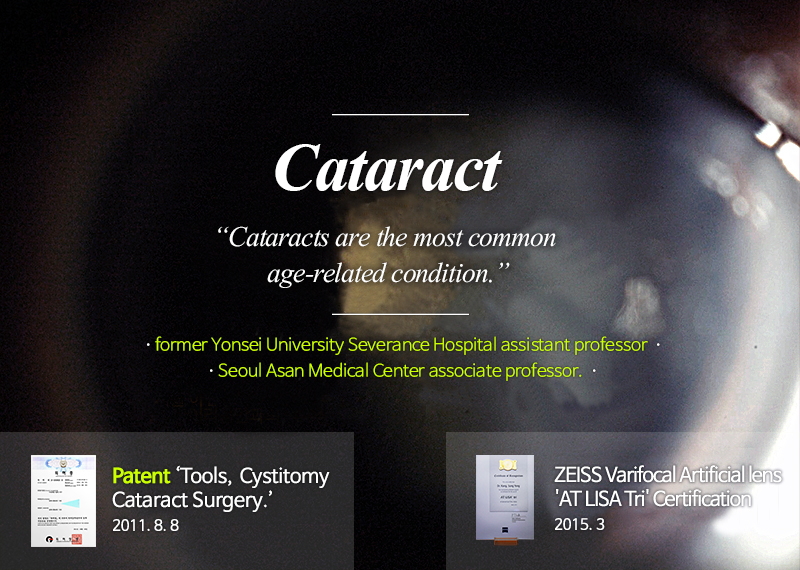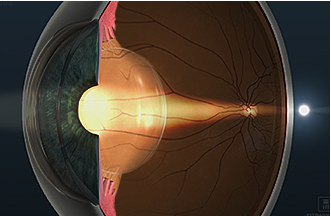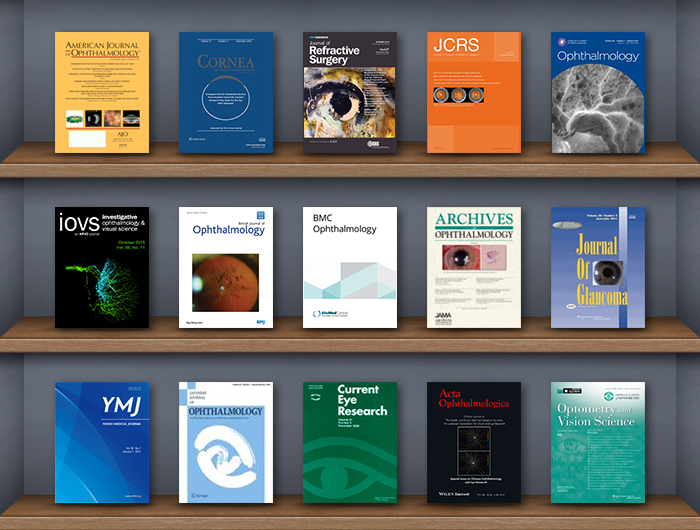


Presbyopia is when the lens loses control power to focus on objects and the dependence on glasses has largely increased.


A cataract is a clouding of the lens which affects vision. Most cataracts are related to aging.
- 01I am 55 years or older.
- 02I suddenly feel my eyes to be dim.
- 03My vision is cloudy and blurry.
- 04When looking at oncoming headlights of a car or any bright light, I feel it is too bright or glaring.
- 05Although I’m wearing glasses, objects don’t seem to be vivid as they once were.
- 06Objects seem to be over-lapping.
- 07I experience difficulty in bright places, especially when seeing nearby objects.
- 08My vision seems to be clearer indoors or in dark places.
- 09I am able to read or see close details better without my reading glasses.
※ If you can relate to four or more of the conditions listed above or have felt a recent change in your vision, you should consult your eye specialists to see if you should receive corrective surgery.



Cataract is the top ranking disease for the elderly (above 65 years old) with 190,000 surgical patients in 2014 and the number of patients is rising by 4% each year.
70% of cataract patients are in their 50s and 60s, proving that it is the most common senile ophthalmopathy that occurs as the eyes start to age. Cataract is most commonly due to aging but may also occur because of trauma, diabetes or be present from birth. The lens becomes cloudy and opaque which leads to a decrease in vision.
Senile cataract is part of the natural aging process. The lens in the eye consists of 60~70% water and 30~40% protein. As we age, the protein may clump together and start to cloud a small area of the lens.
※ Other risk factors for cataract other than aging include:
- Certain diseases: diabetes
- Personal behavior: smoking, drinking alcohol
- Ultraviolet radiation from sunlight or other sources
- Family history
- Precious eye injuries or inflammation
- Other eye diseases: uveitis, glaucoma, retina detachment
- Prolonged use of corticosteroid medication
A cataract starts out small and at first has little or no effect on your vision. You may then notice that your vision is getting a little blurry. Depending on the location of the lens opacity, vision impairment symptoms will be different. Partial opacity may cause monocular diplopia, also known as double vision.
The lens nucleus (the central portion of the lens) hardens and increases refraction, improving close-up/near vision. Sometimes this symptom is mistaken for presbyopia and is neglected. However, if neglected, it can be the leading cause for glaucoma and other complications. The location of opacity in the lens and the degree of it can affect how blurry and distorted your vision is. One of the characteristics of cataract is that although cloudiness has occurred, you are able to distinguish brightness of light and shadows.
Vision impairment due to cataracts can be treated with surgery, so if you start to feel your vision becoming blurry, you should contact your eye specialist.



- 01Topical anesthetic eye drops are put in and a tiny incision (under 3mm) is made in the cornea.
- 02A high-frequency ultrasound device breaks up and removes the cloudy lens. This procedure is called phacoemulsification.
- 03A monofocal or multifocal lens is inserted in the same location as the removed natural lens.
▪︎ What is phacoemulsification (ocular ultrasound)?
Pracoemulsification is a procedure in which an ultrasonic device is used to break up or emulsify the lens and then aspirate it from the eye. Unlike the standard method where a 8~10 mm incision had to made, only a tiny cut smaller than 3mm is made allowing a faster recovery without stitches.
Q. When should I have the surgery?
A. Unlike with many diseases, you don't have to have cataract surgery right after being diagnosed with cataracts. It is generally recommended to have the surgery only when cataracts begin to prevent you from going about your daily activities. However, cataracts are left untreated for too long, surgical treatment may not be possible and the risk of getting glaucoma increases. Once you have been diagnosed, it is recommended that you get regular check-ups once every 6 months.
Q. Do I have cataract surgery on both eyes simultaneously?
A. If you have cataracts in both eyes, surgery typically isn’t performed on both eyes at once. Surgery is performed on one eye first, and then a few days or weeks later it is performed on the second eye. This allows the first eye to recover and your vision in that eye to stabilize before surgery is performed on the other eye.
Q. Can I have cataract surgery even if I am very old?
A. Just because you are old, it doesn't mean that surgery is impossible. Cataract surgery is performed under local anesthesia, so as long as you are healthy enough to cooperate during surgery, age is not a big factor.The lenses of a young person have elasticity , and when looking at an object close by, the ciliary muscles contract and the lens becomes a think magnifying glass shape. This action is like the auto-focus function of a camera. The thickness of the lens changes automatically to control the focus distance. However as we age, the ciliary muscles and the elasticity in our lens weaken. When a monofocal lens is inserted, the lens loses this auto-focusing function.
There are two types of intraocular lens used in cataract surgeries:
-
01One focus point: monofocal intraocular lens
As monofocal intraocular lens has one focusing distance, it excels in correcting either distant vision or close range vision. Most people have them set for clear distant vision, and wear glasses for reading or close up work. Some may have them set for close range vision, and wear myopia glasses to look at things far away.

ㆍFocus of light with monofocal intraocular lens: Focus on only one distance
-
02More than two focus points: multifocal intraocular lens
Multifocal intraocular lens can improve both distant and close range focus at the same time. So cataract as well as presbyopia can be simultaneously treated. Also, unlike the monofocal lens, they reduce your dependence on glasses by giving you clear vision for more than one set distance.
There are many multifocal intraocular lenses to choose from; AT LISA, LISA-tri, LENTIS Comfort, Restor, Tecnis, etc.
ㆍThe Effects of Light Focusing through Multifocal Intraocular Lens: Provide Both Distant and Near Focus












